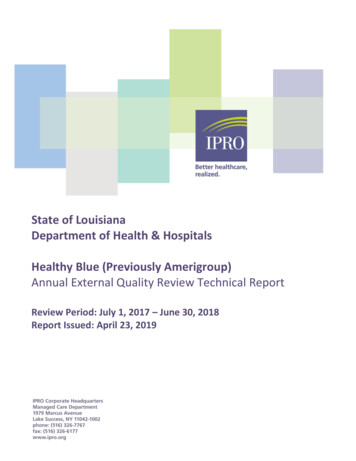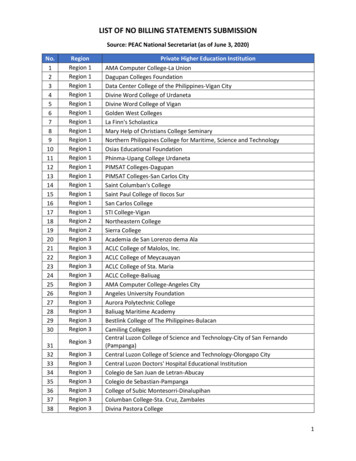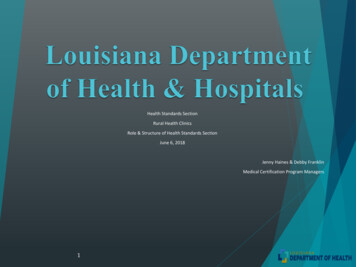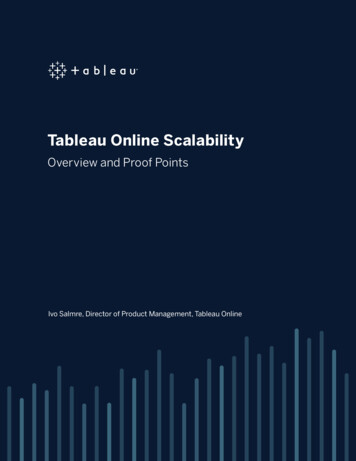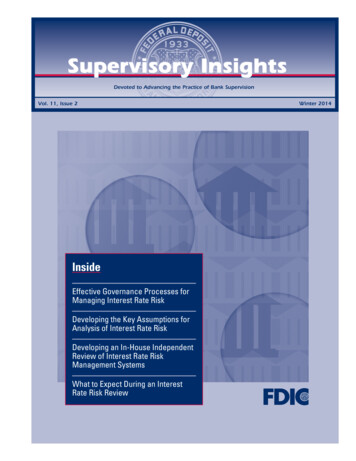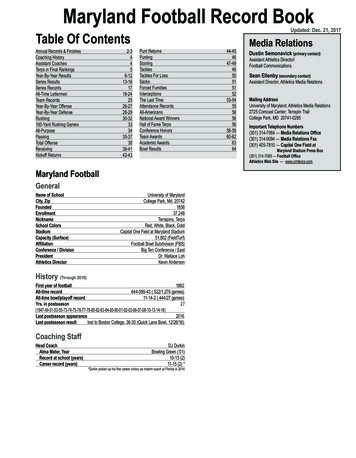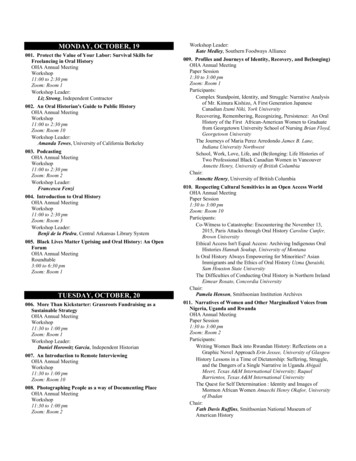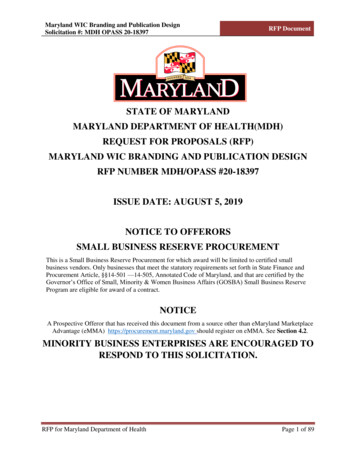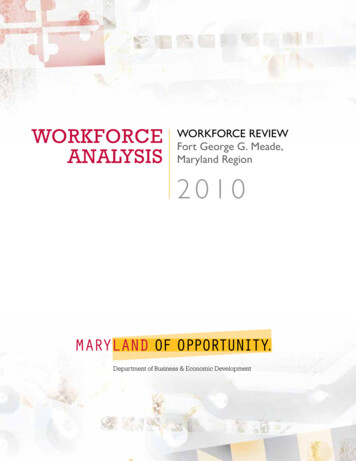
Transcription
WorkforceAnalysisWorkforce ReviewFort George G. Meade,Maryland Region2010
Workforce AvailabilityFort George G. Meade is located approximately halfway between Baltimore and Washington, D.C. in Central Maryland.These two metropolitan areas rank among the top 20 most populous metros in the country. When combined, theWashington-Baltimore-Northern Virginia CMSA (Combined Metropolitan Statistical Area) has a population exceeding eight million, making it the fourth largest in the country behind New York, Los Angeles, and Chicago.Businesses located near Fort Meade draw their workforce from this large labor pool. In addition to beingone of the most populated areas, the labor forceboasts a high degree of professional and technicalworkers, and is also one of the most highly educated.Among the states:Largest Metropolitan Areas by Population – 2009New York-Newark-Bridgeport, NY-NJ-CT-PALos Angeles-Long Beach-Riverside, CAChicago-Naperville-Michigan City, IL-IN-WIWashington-Baltimore-Northern Virginia, DCMD-VA-WV22,232,49417,820,8939,804,8458,440,617 Maryland ranks second in the country in thepercentage of professional and technical workers inthe workforce with 25.4%. (Source: U.S. Census Bureau, 2008 American Community Survey).Source: U.S. Census Bureau Maryland ranks second in the percentage of the population age 25 and above with a graduate or professionaldegree (15.4%), and fourth in the percentage with a bachelor’s degree or higher (35.2%). Source: U.S. Census Bureau,2008 American Community Survey).Measuring WorkforceTwo approaches were taken to measure workforce availability.1. County & Metro data – Traditional boundaries of counties and metropolitan areas were used to define a “laborshed” area for which data from the U.S. Bureau of Labor Statistics was used.2. Drive-Time Analysis – Using Fort Meade as a center point, maps were generated from a geographic informationsystem (GIS) to determine the area within various drive times of Fort Meade. Labor data for these areas were thencalculated using the GIS system as a measure of workforce availability.Robert Rathe
FORT GEORGE G. MEADE LABOR SHEDwww.ChooseMaryland.org
County & Metro dataU.S. Bureau of Labor Statistics and state labor agency data shows more than 1.5 million professional workers in sixselected occupational categories throughout the counties in the Baltimore and Washington areas.Employment by Job Location for Selected OccupationsOccupationOccupational TitleCode (SOC)110000Management Occupations130000Business and Financial OperationsOccupations150000Computer and MathematicalOccupations170000Architecture and EngineeringOccupations190000Life, Physical, and Social ScienceOccupations430000Office and Administrative SupportOccupationsTotalBaltimore MDmetro173,91070,900Suburban Washington NorthernMD 00324,780519,7601,586,080Includes Anne Arundel, Baltimore, Carroll, Harford, Howard and Queen Anne’s counties and Baltimore CityIncludes Montgomery and Prince George’s counties3Includes Arlington, Fairfax, Loudoun and Prince William counties, and the cities of Alexandria, Fairfax,Falls Church, Manassas and Manassas Park12Sources: U.S. Bureau of Labor Statistics (May 2009 data), Maryland Department of Labor, Licensing and Regulation (March 2009 data),and Virginia Employment Commission (May 2008 data)
The Computer and Mathematical category shows 240,950 jobs in the area – about half in Northern Virginia and theremainder spread across the Baltimore area, Montgomery and Prince George’s counties, and Washington, D.C.Employment by Job Location for Computer and Mathematical OccupationsOccupationOccupational TitleCode (SOC)151011Computer and Information Scientists,Research151021Computer Programmers151031Computer Software Engineers,Applications151032Computer Software Engineers,Systems Software151041Computer Support Specialists151051Computer Systems Analysts151061Database Administrators151071Network and Computer SystemsAdministrators151081Network Systems and DataCommunications Analysts151099Computer Specialists, All ations Research Analysts152041Statisticians152099Mathematical Scientists, All OtherAll Computer and MathematicalOccupationsBaltimore MDmetro1350Suburban 6024,6806003006,4103,49020240,950Note: Estimates for detailed occupations do not sum to the totals because the totals include occupations not shown separately.Includes Anne Arundel, Baltimore, Carroll, Harford, Howard and Queen Anne’s counties and Baltimore City2Includes Montgomery and Prince George’s counties3Includes Arlington, Fairfax, Loudoun and Prince William counties, and the cities of Alexandria, Fairfax,Falls Church, Manassas and Manassas Park1Sources: U.S. Bureau of Labor Statistics (May 2009 data), Maryland Department of Labor, Licensing and Regulation (March 2009 data),and Virginia Employment Commission (May 2008 data)Drive-Time AnalysisAn alternate approach to using county boundaries and metropolitan area definitions is to determine the size of thelabor force within a certain drive time of a specific point using a GIS system. For this analysis, the intersection ofMaryland routes 295 and 32 was selected as the centerpoint. Polygons based on drive times of 30, 60 and 90 minutesunder both optimal and rush hour conditions were generated – a total of six separate polygons. In addition to occupational employment, measures including population and educational attainment were also calculated.
OPTIMAL DRIVE TIME FROM FORT GEORGE G. MEADEwww.ChooseMaryland.org
RUSH HOUR DRIVE TIME FROM FORT GEORGE G. MEADEwww.ChooseMaryland.org
Workforce SustainabilityIn addition to the existing workforce, Maryland has a fully-developed network of higher education institutions to replenish the workforce. Virtually every kind of training and research required by business and industry can be obtainedfrom a higher education institution in Maryland. 60 accredited two- and four-year colleges and universities serve thestate. Currently, more than 355,000 students are studying at these higher education institutions, as well as 23,000students enrolled at out-of-state institutions operating in Maryland.Outstanding resources include eleven campuses of the University System of Maryland, as well as the Johns HopkinsUniversity, with particular strengths in information sciences and biotechnology. Educational links to business include theUniversity of Maryland’s Biotechnology Institute, the Maryland Technology Enterprise Institute at College Park, and theJohns Hopkins University Applied Physics Laboratory. Maryland’s sixteen community colleges operate a network of23 campuses and numerous learning centers throughout the state. Continuing education and workforce training areoffered through each college.In 2009 approximately 3,700 bachelor’s degrees were awarded in science and technology fields such as computer science, engineering, mathematics and physical science. Leading universities in the scientific fields include the Johns Hopkins University, University of Maryland, College Park (UMCP), University of Maryland, Baltimore County (UMBC), andthe University of Maryland University College (UMUC). More than 9,000 business degrees are awarded annually, withnearly half of those being master’s degrees. The top schools awarding business degrees include Johns Hopkins, UMCP,UMUC, Towson University and Loyola University Maryland.Degrees by Selected Program, 2009 Maryland Colleges andUniversitiesDegreeProgramBusiness AdministrationComputer ScienceEngineering and TechnologyMathematicsPhysical ScienceSubtotalAll other 64850675615,57429,72845,302Note: Does not include lower division, upper division or post baccalaureate certificates.Source: Maryland Higher Education Commission and U.S. Department of Education IPEDS.A skilled, gifted and availableworkforce is a critical componentfor economic growth and success.Maryland has one of the mostprolific and diverse talent pools inthe country, if not the world, and isstrategically positioned to tap into itsabundant resources to provide andmaintain a ready and able workforce.For additional workforce informationgo to ChooseMaryland.org or call1.888.CHOOSEMDMartin O’Malley, Governor Anthony G. Brown, Lt. Governor
University of Maryland's Biotechnology Institute, the Maryland Technology Enterprise Institute at College Park, and the Johns Hopkins University Applied Physics Laboratory. Maryland's sixteen community colleges operate a network of 23 campuses and numerous learning centers throughout the state. Continuing education and workforce training are
